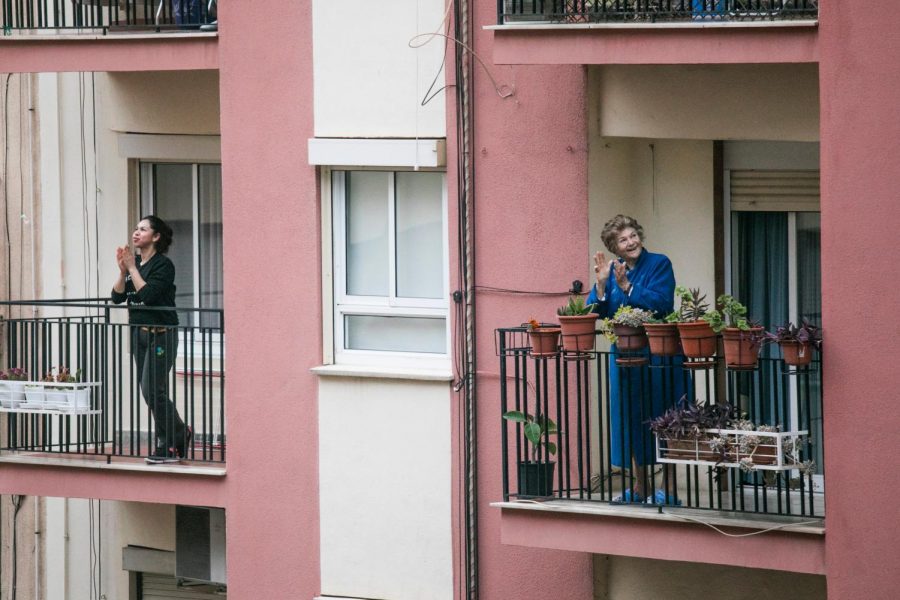How the World Has Transformed Public Spaces During the COVID-19 Pandemic
Outdoor spaces that would typically remain empty during the winter months have now been transformed into some of the only safe options available to the public, during the COVID-19 pandemic.
Manuel Peris Tirado / Unsplash
During quarantine, many have taken advantage of any available outdoor space they may have access to, including balconies.
Outdoor spaces have become an essential part of cities being ravaged by the deadly COVID-19 virus. As a result, businesses have gone to great lengths to make certain activities more accessible and have tried to offer new diverse experiences to keep customers interested. Many initiatives have been taken around the world as cities have realized the importance of maximizing safe access to public spaces. The Bank of America Winter Village at Bryant Park, Watermark Winter Wonderland, and movie nights at The Standard are just a few examples of different outdoor offerings.
While we tend to focus on many of the negative effects of COVID-19, one positive is that it has created a thriving animal care business as dog adoptions and sales have skyrocketed. While pets are a great source of affection, they also provide people with a reason to go outside.
Perhaps the most visible transformation of outdoor spaces is the conversion of sidewalks and roads into outdoor dining areas. During the warmer months, the public responded well to outdoor dining, made evident by the packed restaurants in trendy neighborhoods, now that a cold March 2021 is upon us, it may be harder to enjoy outdoor dining, but, in response to the high demand for outdoor eating space, some restaurants have come up with creative solutions. For example, The Greens on The Rooftop at Pier 17 have heated rooftop dining cabins.
With an increased need for outdoor spaces, parking spaces in cities around the world have been converted into spaces for the public. One such effort in the Netherlands is the city of Rotterdam, which has banned cars after 4 p.m. so that that locals can stroll down streets and explore businesses that have their own outdoor spaces. In Oakland, California, the city has implemented a Slow Streets program in which traffic is stopped on certain streets in order to reduce overcrowding and allow for physical activity. Streetspace for London has created more space for people by constructing temporary bicycle lanes and wider sidewalks. Portland, Oregon has turned parking lots in low-income neighborhoods into farmers’ markets.
Another trend that has grown in popularity during the pandemic is urban farming. A paper from Johns Hopkins Center for a Livable Future shows that urban farming can teach people to appreciate food more as those who participate in a community garden learn what it takes to grow different crops and are therefore able to realize how difficult growing crops actually is. They can also learn about the complexities of the food system, including food waste. Various studies have shown that urban farming has multiple environmental benefits: it can filter out local air pollution, cool down cities in the summer, retain precipitation, and when designed correctly they provide valuable habitats for wild bees and other pollinators.
Other aspects of cities could be affected by the pandemic due to transmission rates. Buildings either have to enforce limits on the number of people inside or possibly make use of outdoor spaces and require more ventilation.
According to a United Nations Policy Briefing, quarantines and distancing ourselves have contributed to greater recognition of how important public spaces are both as a gathering space and for basic needs. People living in urban areas are becoming more aware of public spaces and their role in one’s physical and mental health.
Forced isolation and social distancing have furthered intensified feelings of solitude and anxiety for many. Multiple studies have linked social isolation with adverse health consequences (including depression, poor cardiovascular function, and impaired immunity) at every stage of life; social isolation also increases the risk of premature death from every cause for every race. In recent decades, technology have already contributed to a sense of isolation by making shopping and food accessible from home, eliminating the need to go outside. Studies have shown the numerous benefits of public parks such as promoting public wellness, cleaning the air, providing a space for socialization, encouraging kids’ activity, conserving wild areas, and creating safe gathering areas. Walking, one of the most accessible forms of exercise, has made it possible for some to get the activity and mental self-care they need during the Coronavirus pandemic.
Outdoor activities may be a silver lining in today’s world — they are likely to last after the Coronavirus pandemic and promote the development of healthier and more active cities.
People living in urban areas are becoming more aware of public spaces and their role in one’s physical and mental health.
Jessica Zheng is a Features Section Editor for 'The Science Survey.' She is passionate about reporting on current events that affect the general population...











